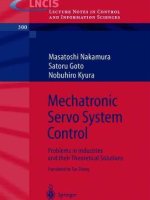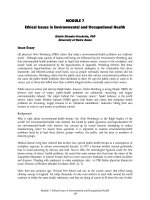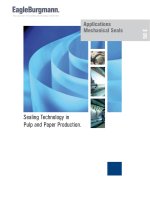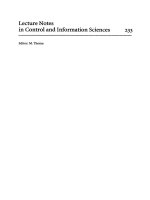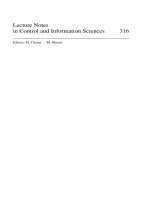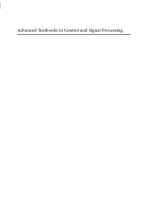Advanced Textbooks in Control and Signal Processing ppt
Bạn đang xem bản rút gọn của tài liệu. Xem và tải ngay bản đầy đủ của tài liệu tại đây (3.64 MB, 429 trang )
Advanced Textbooks in Control and Signal Processing
Series Editors
Professor Michael J. Grimble, Professor of Industrial Systems and Director
Professor Michael A. Johnson, Professor Emeritus of Control Systems and Deputy Director
Industrial Control Centre, Department of Electronic and Electrical Engineering,
University of Strathclyde, Graham Hills Building, 50 George Street, Glasgow G1 1QE, UK
Other titles published in this series:
Genetic Algorithms
K.F. Man, K.S. Tang and S. Kwong
Neural Networks for Modelling and Control of Dynamic Systems
M. Nørgaard, O. Ravn, L.K. Hansen and N.K. Poulsen
Modelling and Control of Robot Manipula to rs (2nd Edition)
L. Sciavicco and B. Siciliano
Faul t Detection and Diagnosis in Industrial Systems
L.H. Chiang, E.L. Russell and R.D. Braatz
Soft Computing
L. Fortuna, G. Rizzotto, M. Lavorgna, G. Nunnari, M.G. Xibilia and R. Caponetto
Statistical Signal Processing
T. Chonavel
Discrete-time Stochastic Processes (2nd Edition)
T. Söderström
Par a llel Computing for R eal-time Signal Processing and Control
M.O. Tokhi, M.A. Hossain and M.H. Shaheed
Multivariable Control Systems
P. Albertos and A. Sala
Control Systems with Input and Output Constraints
A.H. Glattfelder and W. Schaufelberger
Analysis and C ontrol of Non-linear Process Systems
K. Hangos, J. Bokor and G. Szederkényi
Model Predictive Control (2nd Edition)
E.F. Camacho and C. Bordons
Principles o f Adaptive Filters and Self-learning Systems
A. Zaknich
Digital Self-tuning Controllers
V.Bobál,J.Böhm,J.FesslandJ.Machá
ˇ
cek
Robust Control Design with MATLAB®
D W. Gu, P.Hr. Petkov and M.M. Konstantinov
Publication due July 2005
Active Noise and Vibration Control
M.O. Tokhi
Publication due November 2005
R. Kelly, V. Santibáñez and A. Loría
Control of Robot
Manipulators in
Joint Space
With 110 Figures
123
Rafael Kelly, PhD
Centro de Investigación Científica y de Educación Superior de Ensenada
(CICESE), Ensenada B.C. 22800, M exico
Victor Santibáñez Davila, PhD
Instituto Tecnologico de la Laguna, Torreón, Coahuila, 27001, Mexico
Antonio Loría, PhD
CNRS, Laboratoire des Signaux et Systèmes, Supélec, 3 rue J oliot Curie,
91192 Gif-sur-Yvette, France
British Library Cataloguing in Publication Data
Kelly, R.
Control of robot manipulators in joint space. - (Advanced
textbooks in control and signal processing)
1. Robots - Control systems 2. Manipulators (Mechanism)
3. Programmable con trollers
I. Title II. Santibáñez, V. III. Loría, A.
629.8’933
ISBN-10: 1852339942
Library of Congress Control Number: 2005924306
Apart from any fair dealing for the purposes of research or private study, or criticism or review, as
permitted under the Copyright, Designs and Patents Act 1988, this publication may only be reproduced,
stored or transmitted, in any form or b y a ny means, with the prior permission in writing of the
publishers, or in the case of reprographic reproduction in accordance with the terms of licences issued
by the Copyright Licensing Agency. Enquiries concerning reproduction outside those terms should be
sent to the publishers.
Advanced Textbooks in Control and Signal Processing series ISSN 1439-2232
ISBN-10: 1-85233-994-2
ISBN-13: 978-1-85233-994-4
Springer Science+Business M edia
springeronline.com
© Springer-Verlag London Limited 2005
The use of registered names, trademarks, etc. in this publication does not imply, even in the absence of
a specific statement, that such names are exempt from the relevant laws and regulations and therefore
free for general use.
The publisher makes no representation, express or implied, with regard to the accuracy of the infor-
mation contained in this book and cannot accept any legal responsibility or liability for any errors or
omissions that may be made.
Typesetting: Camera ready by authors
Production: LE-T
E
XJelonek,Schmidt&VöcklerGbR,Leipzig,Germany
Printed in Germany
69/3141-543210 Printed on acid-free paper SPIN 11321323
To my parents,
with everlasting love, respect and admiration.
–AL
“Attentive readers, who spread their thoughts among
themselves, always go beyond the author”
—Voltaire
∗
, 1763.
∗
Original citation in French: “Des lecteurs attentifs, qui se communiquent leurs
pens´ees, vont toujours plus loin que l’auteur”,inTrait´e sur la tol´erence `a
l’occasion de la mort de Jean Calas, Voltaire, 1763.
Series Editors’ Foreword
The topics of control engineering and signal processing continue to flourish and
develop. In common with general scientific investigation, new ideas, concepts
and interpretations emerge quite spontaneously and these are then discussed,
used, discarded or subsumed into the prevailing subject paradigm. Sometimes
these innovative concepts coalesce into a new sub-discipline within the broad
subject tapestry of control and signal processing. This preliminary battle be-
tween old and new usually takes place at conferences, through the Internet and
in the journals of the discipline. After a little more maturity has been acquired
by the new concepts then archival publication as a scientific or engineering
monograph may occur.
A new concept in control and signal processing is known to have arrived
when sufficient material has evolved for the topic to be taught as a specialized
tutorial workshop or as a course to undergraduate, graduate or industrial
engineers. Advanced Textbooks in Control and Signal Processing are designed
as a vehicle for the systematic presentation of course material for both popular
and innovative topics in the discipline. It is hoped that prospective authors will
welcome the opportunity to publish a structured and systematic presentation
of some of the newer emerging control and signal processing technologies in
the textbook series.
One of our aims for the Advanced Textbooks in Control and Signal Pro-
cessing series is to create a set of course textbooks that are comprehensive
in their coverage. Even though a primary aim of the series is to service the
textbook needs of various types of advanced courses we also hope that the
industrial control engineer and the control academic will be able to collect
the series volumes and use them as a reference library in control and signal
processing.
Robotics is an area where the series has the excellent entry in the volume
by L. Sciavicco and B. Siciliano entitled Modelling and Control of Robot Ma-
nipulators, now in its second edition. To complement our coverage in Robotics,
we are pleased to welcome into the series this new volume Control of Robot
Manipulators in Joint Space by Rafael Kelly, V´ıctor Santib´a˜nez and Antonio
Lor´ıa. Other topics like models, kinematics and dynamics are introduced into
x Series Editors’ Foreword
the narrative as and when they are needed to design and compute the robot
manipulator controllers. Another novel feature of the text is the extensive use
of the laboratory prototype P elican robotic manipulator as the test-bed case
study for the robot manipulator controllers devised. This ensures that the
reader will be able to see how robot manipulator control is done in practice.
Indeed, this means that the text can be closely linked to “hands on” laboratory
experience. Control and mechatronics lecturers wishing to use the textbook
to support their advance course on robot manipulator control will find the
lecture presentation slides, and the problem solutions, which are available at
springonline.com, an added bonus.
The style of the text is formally rigorous but avoids a lemma–theorem
presentation in favour of one of thorough explanation. Chapter 2 of the text
covers the main mathematical tools and introduces the concepts of the direct
(or second) method of Lyapunov for system stability analysis. This is needed
because the robot manipulator system is a nonlinear system. Since the cover-
age in this chapter includes a wide range of stability concepts, the reader will
be pleased to find each new concept supported by a worked example. Robot
dynamics and their implications for robot manipulator control are covered in
Chapters 3 and 4 whilst Chapter 5 moves on to discuss the model details of
the Pelican prototype robotic manipulator. The kinematic and dynamic mod-
els are, described and model parameter values given. This chapter shows how
the Pelican prototype is “kitted out” with a set of models the properties of
which are then investigated in preparation for the control studies to follow.
Parts II to IV (covering Chapters 6 to 16) are devoted to robot manip-
ulator controller design and performance case studies. This shows just how
focused the textbook is on robot manipulator control. This study is given
in three stages: position control (Part II); motion control (Part Ill) and ad-
vanced control topics (Part IV). Remarkably, the workhorse controller type
being used is from the PID family so that the control focus is close to the
type of controllers used widely in industrial applications, namely from the
classical Proportional, Integral, Derivative controller family. In these chapter-
length controller studies, the earlier lessons in Lyapunov stability methods
come to the fore, demonstrating how Lyapunov theory is used for controllers
of a classical form being used with nonlinear system models to prove the
necessary stability results. The advanced control topics covered in Part IV
include a range of adaptive control methods. Four appendices are given with
additional material on the mathematical and Lyapunov methods used and on
the modelling details of direct current motors.
There is no doubt that this robot manipulator control course textbook
is a challenging one but ultimately a very rewarding one. From a general
viewpoint the reward of learning about how to approach classical control for
systems having nonlinear models is a valuable one with potential application in
other control fields. For robot manipulator control per se, the book is rigorous,
thorough and comprehensive in its presentation and is an excellent addition
to the series of advanced course textbooks in control and signal processing.
M.J. Grimble and M.A. Johnson
Glasgow, Scotland, U.K.
March 2005
Preface
The concept of robot has transformed from the idea of an artificial super-
human, materialized by the pen of science fiction writer Karel
ˇ
Capek, into
the reality of animated autonomous machines. An important class of these
are the robot manipulators, designed to perform a wide variety of tasks in
production lines of diverse industrial sectors; perhaps the most clear exam-
ple is the automotive industry. Robotics, introduced by science fiction writer
Isaac Asimov as the study of robots, has become a truly vast field of modern
technology involving specialized knowledge from a range of disciplines such as
electrical engineering, mechatronics, cybernetics, computer science, mechani-
cal engineering and applied mathematics.
As a result, courses on robotics continue to gain interest and, following the
demands of modern industry, every year more and more program studies, from
engineering departments and faculties of universities round the globe, include
robotics as a compulsory subject. While a complete course on robotics that
is, including topics such as modeling, control, technological implementation
and instrumentation, may need two terms at graduate level to be covered in
fair generality, other more specialized courses can be studied in one senior
year term. The present text addresses the subject in the second manner; it is
mostly devoted to the specific but vast topic of robot control.
Robot control is the spine of robotics. It consists in studying how to make a
robot manipulator do what it is desired to do automatically; hence, it consists
in designing robot controllers. Typically, these take the form of an equation
or an algorithm which is realized via specialized computer programs. Then,
controllers form part of the so-called robot control system which is physically
constituted of a computer, a data acquisition unit, actuators (typically elec-
trical motors), the robot itself and some extra “electronics”. Thus, the design
and full implementation of a robot controller relies on every and each of the
above-mentioned disciplines.
The simplest controller for industrial robot manipulators is the Propor-
tional Integral Derivative (PID) controller. In general, this type of controller
xii Preface
is designed on the basis that the robot model is composed of independent cou-
pled dynamic (differential) equations. While these controllers are widely used
in industrial manipulators (robotic arms), depending on the task to be carried
out, they do not always result in the best performance. To improve the latter
it is current practice to design so-called model-based controllers, which require
a precise knowledge of the dynamic model including the values of the physi-
cal parameters involved. Other, non-model-based controllers, used mainly in
academic applications and research prototypes include the so-called variable-
structure controllers, fuzzy controllers, learning controllers, neural-net-based
controllers, to mention a few.
The majority of available texts on robotics cover all of its main aspects,
that is, modeling (of kinematics and dynamics), trajectory generation (that is,
the mathematical setting of a task to be performed by the robot), robot control
and some of them, instrumentation, software and other implementation issues.
Because of their wide scope, texts typically broach the mentioned topics in a
survey rather than a detailed manner.
Control of robot manipulators in joint space is a counter-fact to most avail-
able literature on robotics since it is mostly devoted to robot control, while ad-
dressing other topics, such as kinematics, mainly through case studies. Hence,
we have sacrificed generality for depth and clarity of exposition by choosing
to address in great detail a range of model-based controllers such as: Pro-
portional Derivative (PD), Proportional Integral Derivative (PID), Computed
torque and some variants including adaptive versions. For purely didactic rea-
sons, we have also chosen to focus on control in joint space, totally skipping
task space and end-effector space based control. These topics are addressed in
a number of texts elsewhere.
The present book opens with an introductory chapter explaining, in gen-
eral terms, what robot control involves. It contains a chapter on preliminaries
which presents in a considerably detailed manner the main mathematical con-
cepts and tools necessary to study robot control. In particular, this chapter
introduces the student to advanced topics such as Lyapunov stability, the
core of control theory and therefore, of robot control. We emphasize at this
point that, while this topic is usually reserved for graduate students, we have
paid special attention to include only the most basic theorems and we have
reformulated the latter in simple statements. We have also included numer-
ous examples and explanations to make this material accessible to senior year
undergraduate students.
Kinematics is addressed mainly through examples of different manipula-
tors. Dynamics is presented in two chapters but from a viewpoint that stresses
the most relevant issues for robot control; i.e. we emphasize certain funda-
mental properties of the dynamic model of robots, which are commonly taken
as satisfied hypotheses in control design.
Preface xiii
We have also included a chapter entirely devoted to the detailed descrip-
tion of the Pelican prototype, a 2-degrees-of-freedom direct-drive planar ar-
ticulated arm that is used throughout the book as a case study to test the
performance of the studied controllers, in lab experimentation. Dynamic and
kinematic models are derived in detail for this particular robot. The rest of
the book (about 70%) is devoted to the study of a number of robot controllers,
each of which is presented in a separate chapter.
The text is organized in four main parts: I) Preliminaries, which contains
the two chapters on robot dynamics, the chapter on mathematical preliminar-
ies and the chapter describing the Pelican prototype. Parts II and III contain,
respectively, set-point and tracking model-based controllers. Part IV covers
additional topics such as adaptive versions of the controllers studied in parts
II and III, and a controller that does not rely on velocity measurements. Ap-
pendices containing some extra mathematical support, Lyapunov theory for
the advanced reader and a short treatment on DC motors, are presented at
the end of the book.
Thus, the present book is a self-contained text to serve in a course on robot
control e.g., within a program of Mechatronics or Electrical Engineering at
senior year of BSc or first year of MSc. Chapter 1 may be covered in one or
two sessions. We strongly recommend taking the time to revise thoroughly
Chapter 2 which is instrumental for the remainder of the textbook. The rest
of the material may be taught in different ways and depths depending on
the level of students and the duration of the course. For instance, Parts I
through III may be covered entirely in about 50 hours at senior year level. If
the course is to be shortened, the lecturer may choose to pass over Chapters
3 and 4 faster (or even completely skip them and refer to their contents only
when necessary) and to introduce the student to kinematics and dynamics
using Chapter 5; then, to focus on Parts II and III. For a yet shorter but
coherent basic course, the lecturer may choose to teach only Chapters 1, 2,
5 and, for the subsequent chapters of Parts II and III, concentrate on a brief
study of the control laws while emphasizing the examples that concern the
Pelican prototype. Further, support material for class -presentation slides for
the lecturer and problems’ solutions manual- are available in electronic form
at springonline.com.
For a graduate course the lecturer may choose to cover, in addition, the
three chapters on adaptive control (Chapters 14–16), or Chapter 13 on control
without velocity measurements and Chapter 14, to give a short introduction
to adaptive control. We remark that the advanced topics of Part IV require
the material in the appendices which could be taught, for instance, at the
beginning of the course or could be left as a self-study topic.
The textbook is written in a style and technical language targeted toward
undergraduate senior students. Hence, we have favored a thoroughly explana-
tory, yet rigorous, style over a stiff mathematical (theorem-proof streamed)
one. We have taken care to invoke a strictly minimum number of mathematical
xiv Preface
terms and these are mostly explained when introduced. Mathematical objects
such as theorems and definitions are kept to a minimum; they are mainly
present in Chapter 2 (mathematical preliminaries) and some appendices. Yet,
when simplicity in the language may induce mathematical ambiguity or im-
precision we have added clarifying footnotes. A large number of examples,
illustrations and problems to be solved in class or as homework by the stu-
dent are provided.
The precedents of the text date back to lecture notes of the first author
that were printed by the National Autonomous University of Mexico (UNAM)
in 1989. It has been enriched by the authors’ experience of teaching the topic
over more than 15 years at undergraduate (senior year) and graduate levels
(first year), in several institutions in Europe and The Americas: National Au-
tonomous Univ. of Mexico (UNAM), Mexico; Technological Institute and of
High Studies of Monterrey (ITESM), Mexico; Center of Research and High
Studies of Ensenada (CICESE), Mexico; Laguna Institute of Technology, Mex-
ico; University of California at Santa Barbara, USA; National University of
Science and Technology (NTNU), Norway; San Juan National University, Ar-
gentina. This has provided the text with invaluable feedback from a varied
audience with different technical and cultural backgrounds. Thus, the authors
are confident to say that this textbook has not been written to be tested but
to be used in class.
A few final words on the nomenclature are necessary. Figures, Examples,
Equations, Tables, Theorems, Lemmas, Definitions are numbered indepen-
dently and carry the number of the chapter. We use the following abbrevia-
tions of Latin idioms:
i.e. –id est– meaning “that is”;
e.g. –exempli gratia– meaning “for instance”;
cf. –confer– meaning “see”;
etc. –etcetera– meaning “and the rest”.
Acknowledgments
The authors wish to thank the Mexican National Council of Science and Tech-
nology (CONACyT) whose sponsorship, to the first author, yielded an early
version of this text (in Spanish). The first author also acknowledges the sup-
port of the Mexican Centre for Scientific Research and High Studies of En-
senada (CICESE). The second author acknowledges the receipt of numerous
research grants from CONACyT and the Council of the National System of
Technological Education (COSNET), which served in part in the elaboration
of this text. Most of the writing of this textbook was realized while the third
author was holding a visiting professorship at CICESE in 2002 and 2003.
The third author acknowledges the grants obtained and praises the extraordi-
nary working conditions provided by the French National Centre for Scientific
Research (CNRS).
Preface xv
The realization of this textbook would not have been possible without
the valuable feedback of numerous colleagues and students throughout the
years. In particular, the first author is thanks Ricardo Carelli and Romeo
Ortega, the collaboration with whom extended over almost 20 years, and
which considerably improved both the contents and writing of the present
book. The authors also acknowledge the numerous exchanges on the topics of
the present book, with Mark Spong, Suguru Arimoto, Carlos Canudas de Wit,
Jean-Jacques Slotine, John T. Wen, Roberto Horowitz, Daniel Koditschek,
Claude Samson, Louis Whitcomb, Harry Berghuis, Henk Nijmeijer, Hebertt
Sira-Ram´ırez, Juan M. Ibarra, Alfonso P´amanes, Ilse Cervantes, Jos´e Alvarez-
Ram´ırez, Antoine Chaillet and Marco A. Arteaga.
Special words of thanks go to Ricardo Campa who actively participated
in the lab experiments presented in the examples throughout the book. The
authors wish to single out the invaluable comments, remarks and corrections
provided by the students of the numerous institutions where this material has
been taught.
The third author takes this opportunity to mention that it was with an
early version of the lecture notes that evolved into this text, that he was
introduced to Lyapunov theory and robotics, by the first author. It is a honor
and a great pleasure to participate in writing this book. He also wishes to
express his deep gratitude to his friend and scientific mentor Romeo Ortega
for his valuable teaching, in particular, on robot control.
The authors acknowledge the valuable assistance of Oliver Jacksson, their
contact editor at Springer-Verlag, London, along the publication process of
this book; from the state of proposal to its realization. Last but not least,
the authors acknowledge both their technical and language reviewers; it goes
without saying that any error in the contents or in the typeset of the present
text is the entire responsibility of the authors.
Ensenada, Mexico Rafael Kelly,
Torre´on, Mexico V´ıctor Santib´a˜nez,
Gif sur Yvette, France Antonio Lor´ıa
May 2005
Contents
List of Figures xxiii
Part I Preliminaries
Introduction to Part I 3
1 What Does “Control of Robots” Involve? 7
1.1 Familiarization with the Physical System under Consideration . 8
1.2 Dynamic Model . . 10
1.3 Control Specifications 12
1.4 Motion Control of Robot Manipulators . 12
Bibliography . 15
2 Mathematical Preliminaries 19
2.1 Linear Algebra 20
2.2 Fixed Points . . . 26
2.3 Lyapunov Stability . . 27
2.3.1 The Concept of Equilibrium 28
2.3.2 Definitions of Stability . . 31
2.3.3 Lyapunov Functions . 40
2.3.4 Lyapunov’s Direct Method . . . 44
Bibliography . 53
Problems . 54
3 Robot Dynamics 59
xviii Contents
3.1 Lagrange’s Equations of Motion . 62
3.2 Dynamic Model in Compact Form 71
3.3 Dynamic Model of Robots with Friction . . 75
3.4 Dynamic Model of Elastic-joint Robots 77
3.5 Dynamic Model of Robots with Actuators . . 82
Bibliography . 88
Problems . 90
4 Properties of the Dynamic Model 95
4.1 The Inertia Matrix . . . 95
4.2 The Centrifugal and Coriolis Forces Matrix . . 97
4.3 The Gravitational Torques Vector 101
4.4 The Residual Dynamics . . 102
4.5 Conclusions 108
Bibliography . 109
Problems . 110
5 Case Study: The Pelican Prototype Robot 113
5.1 Direct Kinematics 115
5.2 Inverse Kinematics 116
5.3 Dynamic Model . . 119
5.3.1 Lagrangian Equations . 119
5.3.2 Model in Compact Form 123
5.4 Desired Reference Trajectories . 128
Bibliography . 131
Problems . 131
Part II Position Control
Introduction to Part II 135
Bibliography . 139
6 Proportional Control plus Velocity Feedback and PD
Control 141
6.1 Robots without Gravity Term . . 143
6.2 Robots with Gravity Term 146
6.2.1 Unicity of the Equilibrium 146
Contents xix
6.2.2 Arbitrarily Bounded Position and Velocity Error . . 148
6.3 Conclusions 153
Bibliography . 153
Problems . 153
7 PD Control with Gravity Compensation 157
7.1 Global Asymptotic Stability by La Salle’s Theorem 159
7.2 Lyapunov Function for Global Asymptotic Stability . . 163
7.2.1 Positivity of the Lyapunov Function 164
7.2.2 Time Derivative of the Lyapunov Function . . . 165
7.3 Conclusions 167
Bibliography . 167
Problems . 168
8 PD Control with Desired Gravity Compensation 171
8.1 Boundedness of Position and Velocity Errors, ˜q and ˙q 174
8.2 Unicity of Equilibrium . 180
8.3 Global Asymptotic Stability . 181
8.4 Lyapunov Function for Global Asymptotic Stability . . 190
8.5 Conclusions 195
Bibliography . 195
Problems . 196
9 PID Control 201
9.1 Lyapunov Function Candidate 207
9.2 Time Derivative of the Lyapunov Function Candidate 209
9.3 Asymptotic Stability . . 211
9.4 Tuning Procedure . 213
9.5 Conclusions 216
Bibliography . 217
Problems . 218
Part III Motion Control
Introduction to Part III 223
10 Computed-torque Control and Computed-torque+ Control 227
xx Contents
10.1 Computed-torque Control . . . 227
10.2 Computed-torque+ Control . . 232
10.3 Conclusions 237
Bibliography . 238
Problems . 239
11 PD+ Control and PD Control with Compensation 243
11.1 PD Control with Compensation 244
11.2 PD+ Control . . 248
11.2.1 Lyapunov Function for Asymptotic Stability . 253
11.3 Conclusions 258
Bibliography . 259
Problems . 260
12 Feedforward Control and PD Control plus Feedforward . . . . 263
12.1 Feedforward Control . 264
12.2 PD Control plus Feedforward 269
12.2.1 Unicity of the Equilibrium 271
12.2.2 Global Uniform Asymptotic Stability 273
12.3 Conclusions 282
Bibliography . 282
Problems . 284
Part IV Advanced Topics
Introduction to Part IV 289
13 P“D” Control with Gravity Compensation and P“D”
Control with Desired Gravity Compensation 291
13.1 P“D” Control with Gravity Compensation . . . 292
13.2 P“D” Control with Desired Gravity Compensation 300
13.3 Conclusions 307
Bibliography . 308
Problems . 309
14 Introduction to Adaptive Robot Control 313
14.1 Parameterization of the Dynamic Model . . 314
Contents xxi
14.1.1 Linearity in the Dynamic Parameters . . 315
14.1.2 The Nominal Model . 319
14.2 The Adaptive Robot Control Problem . . 325
14.3 Parameterization of the Adaptive Controller . 327
14.3.1 Stability and Convergence of Adaptive Control Systems 329
Bibliography . 331
Problems . 334
15 PD Control with Adaptive Desired Gravity Compensation . 337
15.1 The Control and Adaptive Laws . . 338
15.2 Stability Analysis 342
15.3 Examples 349
15.4 Conclusions 357
Bibliography . 358
Problems . 359
16 PD Control with Adaptive Compensation 361
16.1 The Control and Adaptive Laws . . 361
16.2 Stability Analysis 365
16.3 Examples 368
16.4 Conclusions 377
Bibliography . 377
Problems . 378
Appendices
A Mathematical Support 383
A.1 Some Lemmas on Linear Algebra . . . 383
A.2 Vector Calculus . . 384
A.3 Functional Spaces 390
Bibliography . 397
Problems . 398
B Support to Lyapunov Theory 401
B.1 Conditions for Positive Definiteness of Functions . . 401
C Proofs of Some Properties of the Dynamic Model 407
xxii Contents
D Dynamics of Direct-current Motors 411
D.1 Motor Model with Linear Friction . . . 416
D.2 Motor Model with Nonlinear Friction 417
Bibliography . 418
Index 419
List of Figures
I.1 Robot manipulator 4
1.1 Freely moving robot . . . 8
1.2 Robot interacting with its environment. . 8
1.3 Robotic system: fixed camera . . 9
1.4 Robotic system: camera in hand 10
1.5 Input–output representation of a robot . . 10
1.6 Point-to-point motion specification 13
1.7 Trajectory motion specification . . 14
2.1 Concept of equilibrium 29
2.2 Pendulum . . 30
2.3 Notion of stability 32
2.4 Phase plane of the harmonic oscillator . 33
2.5 Asymptotic stability . 34
2.6 Attractive but unstable equilibrium . 35
2.7 Phase plane of the van der Pol oscillator . 40
2.8 Examples 42
2.9 Phase plane of the pendulum . . 46
3.1 Abstract diagram of an n-DOF robot manipulator . . . 59
3.2 Example of a 4-DOF robot . 60
3.3 Example of a 1-DOF mechanism 64
3.4 Example of a 2-DOF robot . 66
3.5 Example of a 3-DOF Cartesian robot . 70
xxiv List of Figures
3.6 Input–output representation of a robot . . 73
3.7 Diagram of a robot with elastic joints 78
3.8 Link with an elastic joint 81
3.9 Example of a 2-DOF robot . 81
3.10 Example of a 2-DOF robot . 82
3.11 Diagram of a DC motor . . 83
3.12 Block-diagram of a robot with its actuators . . 84
3.13 Pendular device with a DC motor . 85
3.14 Problem 2 . . 91
3.15 Problems 3 and 4 91
3.16 Problem 5 . . 92
3.17 Problem 6 . . 93
4.1 Graph of tangent hyperbolic: tanh(x) 103
4.2 Belonging region for g(q
d
) − g(q
d
−
˜
q) 105
4.3 Graph of the function s(
˜
q) 107
4.4 Problem 1 . . 110
5.1 Pelican: experimental robot arm at CICESE, Robotics lab. . . . . 114
5.2 Diagram of the 2-DOF Pelican prototype robot . . . 114
5.3 Two solutions to the inverse kinematics problem 117
5.4 “Bent-over” singular configuration . . 119
5.5 Desired reference trajectories . . 129
5.6 Norm of the desired positions 130
5.7 Norm of the desired velocities vector . . . 130
5.8 Norm of the desired accelerations vector . . . 131
II.1 Position control: closed-loop system . 137
II.2 Set-point control closed-loop system. Input–output
representation. . . . 138
6.1 Block-diagram: Proportional control plus velocity feedback 141
6.2 Block-diagram: PD control 142
6.3 Graph of ˜q(t)
2
151
6.4 Graph of ˙q(t)
2
151
6.5 Graph of the position errors ˜q
1
and ˜q
2
152
7.1 Block-diagram: PD control with gravity compensation . 158
List of Figures xxv
7.2 Diagram of the Pelican robot 161
7.3 Graph of the position errors ˜q
1
and ˜q
2
162
7.4 Graph of the tangent hyperbolic function: tanh(x) 163
8.1 Block-diagram: PD control with desired gravity compensation . . 172
8.2 PD control with desired gravity compensation: graph of the
position error ˜q(t)
2
178
8.3 PD control with desired gravity compensation: graph of
velocity, ˙q(t)
2
179
8.4 Graph of the position errors ˜q
1
and ˜q
2
186
8.5 Bifurcation diagram . 188
8.6 Simulation with k
p
= −11, −4, 3 189
8.7 Catastrophic jump 1 . . . 189
8.8 Catastrophic jump 2 . . . 190
9.1 Block-diagram: PID control 202
9.2 Desired joint positions . . . 205
9.3 Diagram of the Pelican prototype robot 214
9.4 Graphs of position errors ˜q
1
and ˜q
2
215
9.5 Graphs of position errors ˜q
1
and ˜q
2
216
III.1 Motion control: closed-loop system . 224
III.2 Motion control closed-loop system in its input–output
representation 225
10.1 Block-diagram: computed-torque control 228
10.2 Graph of position errors against time . . 232
10.3 Computed-torque+ control . . . 234
10.4 Graph of position errors against time . . 237
10.5 Problem 1. Cartesian 2-DOF robot. 239
11.1 Block-diagram: PD control with compensation . . 245
11.2 Diagram of the Pelican robot 247
11.3 Graph of position errors against time . . 248
11.4 Block-diagram: PD+ control . . . 249
11.5 Graph of the position errors against time . 253
12.1 Block-diagram: feedforward control 265
12.2 Diagram of the Pelican prototype . . . 268
xxvi List of Figures
12.3 Graphs of position errors ˜q
1
and ˜q
2
269
12.4 Block-diagram: PD control plus feedforward 270
12.5 Graphs of position errors ˜q
1
and ˜q
2
282
13.1 Block-diagram: P“D” control with gravity compensation . 293
13.2 Graphs of position errors ˜q
1
(t) and ˜q
2
(t) 299
13.3 Block-diagram: P“D” control with desired gravity compensation 300
13.4 Graphs of position errors ˜q
1
(t) and ˜q
2
(t) 307
14.1 Planar 2-DOF manipulator on a horizontal plane . . 322
14.2 Block-diagram: generic adaptive control of robots 329
14.3 Problem 2. Cartesian robot. . 335
15.1 Graphs of position errors ˜q
1
and ˜q
2
355
15.2 Graphs of adaptive parameters
ˆ
θ
1
and
ˆ
θ
2
356
15.3 Graphs of position errors ˜q
1
and ˜q
2
357
15.4 Graphs of adaptive parameters
ˆ
θ
1
and
ˆ
θ
2
357
16.1 Block-diagram: pendulum under PD control with adaptive
compensation . . . 370
16.2 Planar 2-DOF manipulator . . . 371
16.3 Diagram of the Pelican robot 373
16.4 Graphs of position errors ˜q
1
and ˜q
2
376
16.5 Graphs of adaptive parameters
ˆ
θ
1
,
ˆ
θ
2
, and
ˆ
θ
3
377
16.6 Problem 4. Cartesian 2-DOF robot. 380
A.1 Example A.1: graph of α 390
A.2 Problem 1 . . 398
D.1 DC motor 411
D.2 DC motor with cylindrical inertia . 414
D.3 Pendular device . . . 415
D.4 Nonlinear friction . . 417
Part I
Preliminaries
Introduction to Part I
The high quality and rapidity requirements in production systems of our
globalized contemporary world demand a wide variety of technological ad-
vancements. Moreover, the incorporation of these advancements in modern
industrial plants grows rapidly. A notable example of this situation, is the
privileged place that robots occupy in the modernization of numerous sectors
of the society.
The word robot finds its origins in robota which means work in Czech.
In particular, robot was introduced by the Czech science fiction writer Karel
ˇ
Capek to name artificial humanoids – biped robots – which helped human
beings in physically difficult tasks. Thus, beyond its literal definition the term
robot is nowadays used to denote animated autonomous machines. These ma-
chines may be roughly classified as follows:
• Robot manipulators
• Mobile robots
⎧
⎪
⎪
⎪
⎨
⎪
⎪
⎪
⎩
Ground robots
Wheeled robots
Legged robots
Submarine robots
Aerial robots
.
Both, mobile robots and manipulators are key pieces of the mosaic that con-
stitutes robotics nowadays. This book is exclusively devoted to robot manip-
ulators.
Robotics – a term coined by the science fiction writer Isaac Asimov – is
as such a rather recent field in modern technology. The good understanding
and development of robotics applications are conditioned to the good knowl-
edge of different disciplines. Among these, electrical engineering, mechanical
engineering, industrial engineering, computer science and applied mathemat-
ics. Hence, robotics incorporates a variety of fields among which is automatic
control of robot manipulators.




